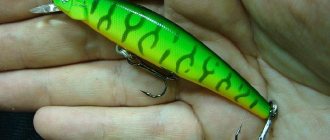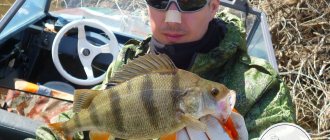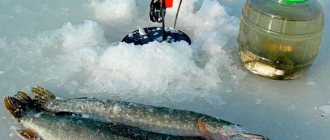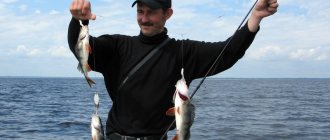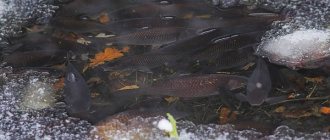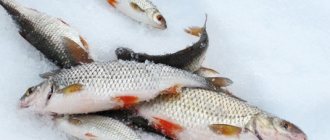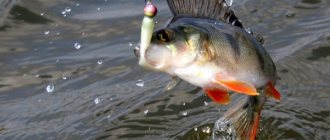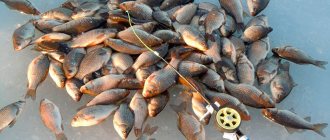Donka is recognized as an effective summer tackle, despite its simplicity, bordering on primitiveness. Meanwhile, the donke is also used in the winter, and in a completely strange form, which is probably why such a donke is also called a “fool” , as well as: fishing with a ball, with a tug, with a roller, fishing with a twitch, and so on. This winter tackle can work like a regular stationary donka, waiting for a bite in a mode called “standing” . But its fundamental features and advantages are fully manifested when this donkey works on the principle of a running donkey. How is this possible if there is simply no place for wiring such a donkey? Everything is limited by the space of the hole. This is what this article will discuss. And, probably, the most important element of the “fool” is the spherical heavy sinker. This could be a massive “Cheburashka” sinker with a bitten off ear, a bullet, or another sinker that has a streamlined shape. But everything is in order.
Donka-twitch, skating
Despite the abundance of different names, this winter donka represents approximately one pattern, differing depending on the fishing conditions and, first of all, on the strength of the current. Sometimes the method of attaching the leash is different, as well as the length of release of the hook with the nozzle downstream.
This is a very successful tackle that works where fishing with a jig is almost impossible. But sometimes the rod works in a team with other gear, that is, with jig fishing rods. Typically these are places with weak to moderate currents. Here, fishing rods with an open reel, a long whip and a rigid nod, which can be of a universal type, namely a spring nod, are used for fishing with a spring, which allows you to adjust the rigidity of the nod for different fishing conditions. The sinker used weighs no more than 6-8 grams . It could be a ball or an olive weight. The leash is tied below the sinker to the swivel. Some fishermen attach a leash above the sinker and tie a luminous jig when the depth at the fishing spot is about 10 meters . All connections must have swivels , otherwise the tackle will twist and get tangled during the current.

Jerking or fishing by stretching
A simple but effective tackle for fishing in the current in the right hands. Sometimes dergusha is classified as a poacher's fishing gear, which is not true. The rig uses only one hook and fish is caught honestly - in the mouth. Mainly white fish bite on the jerk, but it is also possible to catch bottom-dwelling pike perch or bersh. They use jerk on rivers with significant currents and depths, where it is not possible to fish with a jig or float rod. The oxygen regime in large rivers is always good, there are no dead times and the fish are always active, which gives hope for a good catch. It’s good if you know bream trails, if not, you’ll have to look for them and drill a lot, the only consolation is that the ice on rivers is always thinner than in lakes. For twitch fishing, in addition to an ice screw, you will definitely need a hook and some kind of long stick with a slingshot at the end. Often, when removing the equipment, the load - the ball gets stuck behind the lower edge of the ice, most often this happens in the spring, when a rigid fishing line cuts through the ice that is weakening from below and the ball can only be removed with a slingshot. When fishing with jerk, the hole is drilled only at an angle towards the current.
Fishing rod for twitch
The rod for this equipment should be light, long, durable and moderately rigid.
The optimal length of the rod is up to 1 m - 1.2 m, which will allow you to make a good swing of the hand and fully guide the ball against the current. Modern telescopic fishing rods are very suitable for this fishing. The fishing line for jerk fishing is used with a rigid line and a diameter depending on the weight of the load, usually 0.25 is enough. They wind the fishing line on a reel for at least 50 meters, since the release is sometimes done at a distance of 20 - 25 meters. The reel should hold a large amount of line and be easy to release as needed. It is better to install the load in a spherical shape; it easily slides along the bottom, sometimes rolling along it and bouncing, almost does not get stuck and rolls much further than the load in the shape of the same olive. It is better if the load is through and not tied through a ring; a through load has more freedom, it glides easier and allows you to fish a larger area of the bottom. Of course, with this method of fastening, in order to change the load to one suitable for the fishing conditions, the equipment will have to be torn and re-tied. To avoid doing this on the river, it is worth having several fishing rods with loads of different weights. The weight of the ball is selected based on the strength of the current; it should be carried a little by it, at times sinking to the bottom and rolling along it. You should constantly feel the sinker moving along the bottom. It is very difficult for a beginner when fishing with a jerk to choose the appropriate weight; here you need to try with a larger (within reasonable limits) weight and feel the behavior of the sinker on the bottom. When fishing with this tackle, the leash is set with a diameter two numbers smaller than the working line. The length of the leash depends on the load; the heavier the ball, the longer the leash; more than a meter is usually not used. A nod when fishing with a twitch does not indicate a bite; it serves to control the bottom; without this, fishing is not possible. The rigging of the tug is not complicated; the chosen sinker is placed on the working line, then a stopper in the form of a rubber or other soft bead. If it is not there, the heavy sinker will gradually break the knot on the swivel, which is tied to the end of the main fishing line. A leash with a hook is attached to the other end of the swivel using a loop-in-loop method; less often a jig is used. It turns out a fishing line + weight + bead + swivel + leash with a hook. They don’t spare bloodworms for such a glutton as bream and plant at least a dozen of them, checking the bait after each bite or touching the bottom.
Wiring

The tug is lowered into the hole sequentially, first a load - a ball, followed by a leash with a hook (it won’t get tangled), having felt the bottom with the load, pull out a couple of meters of fishing line and pull it against the flow, after which the ball is dropped to the bottom again. You can tap the bottom with a ball and make a few pulls, if there is no bite that you definitely feel with your hand, some more fishing line is released and everything is repeated. Swinging the rod during which the ball comes off the bottom and rolls further, constant bleeding of the fishing line, pulling, tapping the weight on the bottom constitute the game of twitching. Whatever you do with it, contact with the bottom must be constant even with a very long release of the ball. The further the ball rolls, the worse the bite is felt; it is usually felt during the pull as a blow or sudden heaviness. Some fishermen's twitching maneuvers are very reminiscent of shamanic dances with a tambourine.
Donk fishing technique
First, the load is lowered to the bottom, then it is tapped, small oscillatory movements are made with a nod, followed by a long pull along the entire length of the fishing rod and hand. If the tackle stands motionless at the hole, then here too it works quite actively due to the force of the current, but still the most effective way to catch fish is by pulling the tackle. After a long pull, the sinker is again released downstream to the hole. In this case, smooth oscillatory movements of the tackle can be made.
The bite most often follows on a stretch. After several unsuccessful pulls and drops of the sinker, the line is usually released from the reel and the sinker goes downstream about two meters. And everything repeats itself again and again. Such a drop and movement of the sinker downwards can be even 50 meters , but more often the weight and the hook with the nozzle do not move further than 10-20 meters from the hole. The main thing is to select the weight of the sinker so that it is pulled a little by the current, that is, so that the load rolls along the bottom, as the name of the tackle suggests.
For winter fishing on the slope, the most common bait is used - bloodworms . But closer to spring, often the most attractive bait for large fish is a worm .
To fish with a twitch-roll, you should drill holes not vertically , as jig fishers usually try to do, but at an angle towards the current .
This reduces the friction of the fishing line on the edge of the hole and its cuts, especially in cold weather, when these edges become hard and sharp, like glass.
The best plant-based baits for bream
Bait for bream is the main constant on which the future catch depends. As bait, you can also use semolina with the addition of flavors that fish love. Let's list the favorite smells of bream: garlic, dill (grains), thyme, vanilla. This fish can feel them even at a distance of several meters.
If bream fishing takes place on a large river, then Salapin porridge can be used as feed. Salapin porridge for bream can be prepared the day before the intended fishing. This porridge contains: pearl barley, millet, sunflower oil, barley, and corn grits. Granulated sugar (1 tsp) can be added as a sweetener.
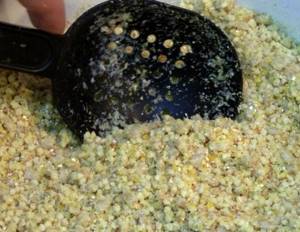
Among the plant options when catching bream, the use of mastyrka stands out. Mastyrka for bream is quite popular among fishermen. In addition to semolina and pea flour, it contains food coloring and sunflower oil. When choosing a dye, the best solution would be to choose yellow options. Preparation of mastyrka:
Take a 2-liter saucepan and add the specified flour and cereal into it in equal parts. However, a number of fishermen prefer to put in a little more pea flour compared to semolina. Add a pinch of dye, pour water to the edges of the mixture lying in the pan, and put it on the fire. After boiling, keep the prepared mastyrka on the fire for about a third of an hour, while stirring it periodically. At the end of the allotted cooking time, add 1 tsp. vegetable oil and mix everything. After cooling, the resulting consistency can already be used in practice. You can also highlight the following recipe for mastyrka for catching bream, which is prepared in the same way, but the following ingredients are taken:
- · Pea flour 250 grams;
- · Semolina 150 grams:
- Wheat flour 100 grams
- · 1 tbsp. a spoonful of linden honey and sunflower oil.
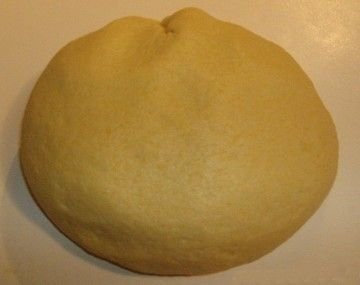
It should be noted that when fishing for bream, the mastyrka sits quite well on the hook, and after direct immersion under water, it attracts the bream with its smell and color. It can be attached not only to a hook, but also to fill a feeder with it or use it as bait.
If you catch bream, you can put sprouted peas on the hook, even combining it with a worm or bloodworm. You can also use an ordinary field grasshopper as bait on hot sunny days. It is advisable to fish with a live specimen, as it will be more attractive to bream. So, we figured out what bream is caught with.
Catching bream with lard and polystyrene foam
Fishing for bream with lard is quite popular among many fishermen. It is recommended to use streaky lard either alone or in combination with animal baits (worms or bloodworms). If you want to flavor lard, then the best odors are of animal origin, the same ground worms, maggots, bloodworms. You can catch bream using lard in almost any body of water. Lard can be either salted or unsalted. It is important to use fresh product without skin. Not a single bream will bite on stale lard.
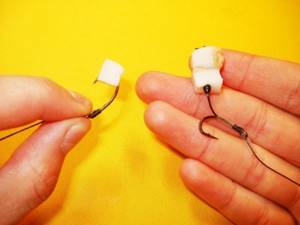
Catching bream using polystyrene foam, foam balls, is also a fairly effective way to catch this fish. In some cases, before starting fishing, the fisherman flavors these elements with the smells that bream loves. The main thing is not to scare off the bream with a strong smell. It is also important to choose an appropriate feeder where you can fill the bait with hooks. Gradually dissolving, it creates a corresponding cloud of turbidity that attracts fish. Rolled porridge may be suitable as complementary food that is stuffed into the feeder. A twisted spring feeder weighing 70 grams is usually weighted with lead weights. If catching bream on a feeder takes place in the right place, then the fishing will be successful.
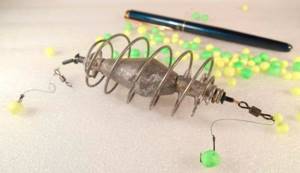
Using a nipple and jerk to catch bream
Dergusha is an effective tackle, or rather a method of catching fish, used for catching bream, especially in places where there is a current. Dergush for bream includes one hook. This method is advisable to use if fishing on the river with a jig is not possible. As a result, the fisherman can count on a good catch. The fishing rod used must be equipped with a reel and have rings through which a fishing line with a diameter of 0.25 mm must pass.
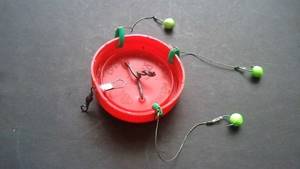
The bream nipple rig is also great for catching bream. If you make it yourself, you will need a regular water cap from a plastic bottle (5 liters). A special lead weighting material must be attached to the outside. You can also make 2-3 holes through which hooks and fishing line will pass. It is recommended to use hooks from number 10 to number 14. You will need to place foam balls on the tip of the hooks, and put bait, for example, mastyrka, in the lid. In this case, a weighting agent is necessary so that the resulting nipple does not turn over. At the place where the fishing line passes through the lid, you need to install a small long cambric. When trying the bait, the bream on the foam plastic, which will float on the hook, will definitely bite. Here you can also use an ordinary plastic plug, where you can place hooks together with the bait in the form of a fairly viscous porridge. All this will be located at the bottom. The bream, sucking up such bait, will also swallow the hooks.
Thus, catching bream on a nipple presupposes the presence of a strong, invisible fishing line, thin hooks, and aromatic bait. To catch a fish when it bites, it is necessary to have a baitrunner with a friction brake on the fishing rod.
Winter donka for fast currents and great depths
For conditions of fast current and decent depth , where it is impossible to fish with a jig and a light roll, other gear is used. The basis is a flexible rod about 1-1.5 meters long without a nod . This could be an old spinning rod of the ultralight category, shortened or even up to 2 meters . This seemingly unsuitable length of the rod for winter allows, nevertheless, to make very long pulls towards yourself and to the side. This increases the fishing sector even without removing the line from the reel.
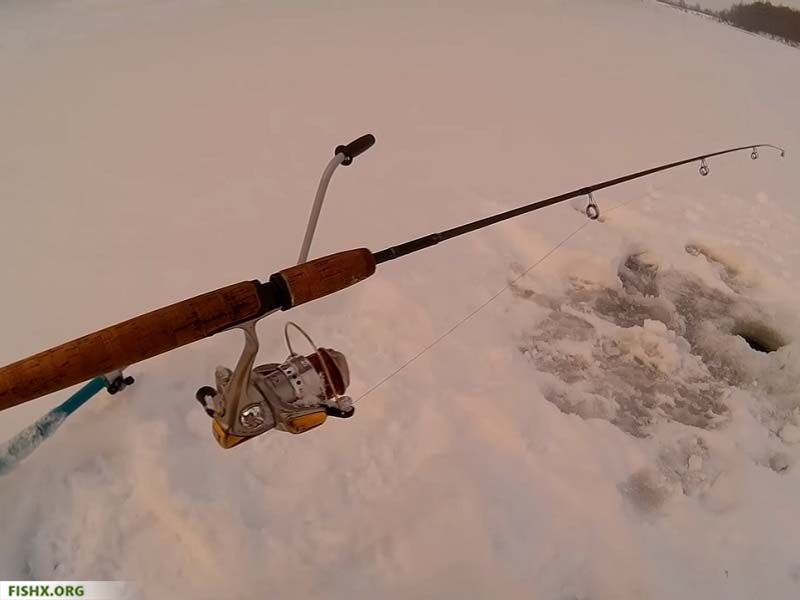
In such places, bullet sinkers weighing from 8 grams and in the range of 20 and even 30 grams are used. The main line is not very thin, which increases its windage and the sinker goes down better. Usually it is a monofilament line with a diameter of 0.25 mm . For fishing it is better to use a spinning reel . The leash supplied with a thinner line – 0.14 mm thick. The hook used is thin - No. 4-5 of our numbering.
Share with your friends!
Palych's fishing newsletter
I spent my childhood in Yakutia, so I started catching grayling fish very early. They caught it in different ways, but all the methods were not poaching. And there was no temptation, the nets could only be seen in Soviet times in the picture, they didn’t do any kind of pinning (I don’t know why), everyone used a fishing rod. The simplest way was to make a fishing rod from young larch, tie a fishing line, and tie a fly to the fishing line. Something like modern tenkara. They rubbed the fishing line with a paraffin candle to prevent it from sinking quickly. Most often they took a dry fly, but they also caught a wet one. In general, I was very surprised when I found out about tenkara. They have been fishing this way in Siberia for a long time and they called it “catching grayling with a wire.” This way they were caught mainly on small rivers and streams. So that again our original Siberian method is not attributed to American, Czech or Japanese methods, I want to tell you about another method for catching grayling in Siberia. This method was called “catching grayling with a twitch”.In Soviet times, we made the fishing rod ourselves, from young larch. Now you can take an ordinary winter spinning rod with a reel (so that in working form it will be 50 - 60 centimeters long. We wind 50 meters of fishing line on the reel, with a diameter of 0.2. We make a leash with a diameter of 0.17, and occasionally we make a catch with another fly. This is usually at the beginning of fishing, to pick up a fly. Another important component of such fishing is a waterproof overall. In our childhood, the OZK suit was very valued, here you have a raincoat and overalls. Now you can choose any waterproof overalls.
Twitch fishing is popular, as is all grayling fishing. We go into the water, float 20 - 30 meters of fishing line with flies and pull it up. We don’t stand still, we quietly move forward and backward across the river. Grayling is not afraid of humans in the water and greedily grabs the bait. By the way, we rarely used flies for twitching; we mostly tied a hook (without sinkers, of course) and caught them with an ordinary dung worm. This was explained simply, especially large specimens were taken on the worm, and the fish caught it more often. And knowing where the grayling usually stands, it was possible to quickly catch a promising place and move on to a new one. On small and overgrown rivers, where walking was very difficult, they used a boat (rubber, it is quiet and does not make noise). You float to a promising place, tie yourself to a bush and let’s pull. If a particularly large specimen bites, you won’t be able to pull it out against the current. You felt it right away; you had to go ashore and run down the bank, otherwise there was no way to pull it out. A lively grayling will unscrew its lip, but lenok or taimen will simply fall off.
They were also equipped with a pouch on a belt for this fishing; some lucky ones had bags for gas masks instead of pouches. Fish were placed in these bags (bags) when fishing. Grayling fish is delicate and, especially in the heat, spoils very quickly. So we had to periodically go ashore and return to the anchorage to gut and add salt to the fish. At the parking lot, the fish were already put into the paiva. A paiva is a box with straps, like a backpack. They made paiva from plywood, then when sheet metal came in, they began to make it from galvanized iron or aluminum. In these iron pievas, the salt was already in plastic bags, but we liked the plywood pievas more, and we were proud of them in front of each other...
Years have passed and I haven't caught fish this way for a long time. In 2003, my son and I went on vacation to the Altai Mountains. During our journey, we took us to the Endigan River. The river is small, one might say a stream, and even overgrown. I caught a couple of graylings at the mouth (we stopped at the confluence of the Endigan and the Katun) and that’s all - they didn’t bite. So I had to remember childhood fun, make a twitch and go fishing in the stream. So not only did I catch it on the fish soup, but also on the fry! Then, after that, I caught some good fish on Bolshoi Ilgumen! So you can’t forget the old ways of fishing!
Discuss and watch the tricks on the forum of the “Vagabonds” club website.
